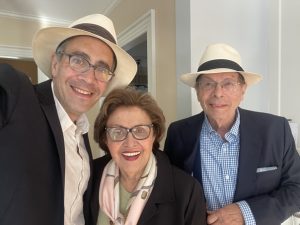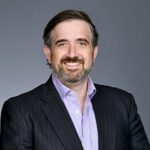On The Bright Side: Better Medicines, Shared Purpose, Good Listens

David Shaywitz
While visiting my parents on Memorial Day weekend, I reflected on the wonder and joy of a life in medicine and science — theirs as well as mine.
Incredible Progress in Medicine
My parents are academic physician-scientists at Yale Medical School, where they founded and continue to lead the Yale Center for Dyslexia and Creativity. Now in their early 80s, they are as active and engaged as ever, reading the literature, leading a research team, and giving talks. Just a year or so ago, their Coursera course, “Overcoming Dyslexia” went live, and has now enrolled over 40,000 learners.

David, Sally and Bennett Shaywitz
On the morning of Memorial Day, my dad and I, both early risers, were sipping coffees at the kitchen table when he began to reflect on how much medicine has changed over the course of his career in pediatric neurology.
He described clinical neurology before contemporary neuroimaging like CT and MRI scans. Before their arrival, my dad said, neurologists had few tools beyond the classic neurological exam, an approach that is elegant, even charming in theory, but historically has been largely unfalsifiable in practice. This changed, he said, when noninvasive neuroimaging arrived and gradually revealed the limitations and often specious conclusions of the beloved physical exam.
Procedures were different as well. In the days before advanced noninvasive imaging, I was told, children with meningitis often received a subdural tap, meaning a needle was stuck into the skull to remove a potential effusion (fluid buildup). With the advent of CT imaging, neurologists quickly learned that effusions were common in these patients and would typically resolve on their own. Bacterial meningitis itself has become far less common than it was decades ago, due to the introduction of vaccines that protect against the most common causes.
My mom, who soon joined us at the table, reminded me that imaging also impacted other medical specialties, including obstetrics. When she was pregnant with twins, I learned, doctors struggled to make this determination; a plain X-ray film (with its associated radiation exposure) was ultimately required to be certain. Obstetrics was considerably riskier than today, and pediatricians (particularly pediatric neurologists) would often see infants with injuries from difficult deliveries.
It was also common, my mom recalled, for pediatricians to encounter children who suffered from viral conditions now preventable with vaccines. She saw many kids who were born deaf following maternal infection with rubella. There were also a number of children each year who she saw die from measles. In addition, it was not unusual to encounter adults (including my mom’s best friend) who were crippled because of a polio infection in childhood.
My parents also recall frequently seeing young patients with lead poisoning. Sometimes children would come in with seizures, or occasionally in a coma, because of lead-induced encephalopathy. Often, this happened when small children would pick up and eat bits of lead-containing paint. Since the late 1970s, when the manufacture of lead-based paint was banned and awareness of the health risks rose, fewer kids now suffer these symptoms.
(I would be remiss not to point out that our ability to identify and effectively support children and adults with dyslexia is also far better than it was years ago, reflecting the work of researchers like my parents and others.)
The progress my parents have seen across their careers – largely attributable to improved imaging technology, the development of highly effective vaccines, and impactful public health measures likes universal childhood vaccinations and the mandated removal of lead — is extraordinary. The capabilities we have today to diagnose and treat illness are so much more powerful than when they started. To me, this reinforces why, if asked the question “If you could pick any time to live, when would you choose?” the response must be today — unless tomorrow is an option.
Things are getting better – as neuroscientist Steven Pinker, among others, reminds us.
To be sure, while improved technology and medicines offer the possibility of better health, this promise will only be realized through access, and this remains a profound concern. A recent Wall Street Journal headline announced, “Cancer is Capsizing Americans’ Finances,” while a recent South Park lampooned the byzantine process required in the U.S. healthcare system to access GLP-1 medicines for diabetes and weight loss.
Our challenge here is finding a way to address the urgent need to ensure access to the best care available today while simultaneously continuing to incentivize the development of even better diagnostics and therapeutics (including those like vaccines aimed at preventing rather than treating disease) for future generations.

Craig Garthwaite, professor of strategy, Northwestern University’s Kellogg School of Management
As Craig Garthwaite, a health economist at Northwestern University, nicely frames it, the need for better treatments can be seen as another category of access challenge.
“I’ve lost close family members to cancer that didn’t yet have treatments available,” he writes. “The hardest part for them wasn’t affording it. A lack of innovation is the access problem we often overlook because it isn’t as salient — but it is a far larger barrier than price (emphasis added).”
Today, no one can access desperately needed transformative medicines for conditions like glioblastoma, pancreatic cancer, and Alzheimer’s Disease; they haven’t been invented yet.
Diversity of Global Science
While home, I also came across mementos I saved from lab experiences over the years. One example: a 24-well plate signed and gifted to me nearly four decades ago by a colleague (now a professor at UCSF) in tribute to the weeks we spent one summer in the Janeway lab at Yale doing an assay using these plates over and over (and over).
Reflecting on my experiences in science, both in academia and industry, I was struck by the incredible diversity of people I’ve worked with, reflecting so many different paths and life experiences and even politics.
For instance, while most researchers tend to shade to the left, I vividly remember a phenomenal technician from the Janeway lab who proudly wore a belt buckle proclaiming “God, Guns, and Guts Made America Great.” I also recall a postdoc from my PhD lab who was emphatically pro-life, and who has gone on to a highly successful career in science, now leading drug discovery at a prominent AI company.
Science is intrinsically international. Difficult and compelling problems attract passionate researchers from across the world. An incredible privilege of a life in and around science is how second nature it becomes to collaborate with colleagues from everywhere.
In college, I learned molecular biology next to brilliant colleagues who had grown up in places like India and Iran and are now accomplished biomedical scientists and entrepreneurs. In the labs I’ve worked in, it was routine to see a postdoc from South America next to a postdoc from Eastern Europe next to a graduate student from Michigan.
Scientists at the companies where I’ve worked also came from around the globe; in my last role, at a company headquartered in Japan, the Chief Data and Technology Officer hailed (very, very proudly) from Ireland; innovation in pharmaceutical sciences was driven by a brilliant colleague from Austria; and the physician-scientist leading the gastroenterology, immunology, and inflammation therapeutic area had emigrated from Nigeria when he was eighteen.
Diversity in science includes religion as well.
In the Tonegawa lab, at MIT, a Mormon graduate student helped me better understand the purpose and fulfillment of missions. At Takeda, a talented epidemiologist and officemate shared his experience fasting for Ramadan, and the joy of Eid al-Fitr as the month-long observance concludes.
That’s not to say, of course, that science is as representative as it needs to be if it is to truly capture the full potential of the most capable minds in the world. In my last role, an exceptionally effective African-American vice president and science technology leader would poignantly lament how few African-American colleagues there were at senior levels in the organization, a disparity he worked passionately to address.
Compared to the perfect state, science clearly has a distance to go.
But there is so much about the community of science that is encouraging, including its ability to attract global talent with diverse viewpoints to pursue collaboratively the shared goal of better understanding nature, and if we’re lucky, translating this understanding into more effective treatments for patients wherever they live, and whatever their politics and beliefs.
Good Listens
My drive from Massachusetts to Connecticut also afforded me the opportunity to catch up on some podcasts; here are a few episodes that might be of interest.
- Acquired episode, discussing Microsoft’s early days. Fun fact: Windows was Plan B.
- WSJ – The Future of Everything episode featuring the always interesting “Science of Success” columnist Ben Cohen discussing how Birkenstock’s became such a big deal.
- Invest Like The Best episode, discussing how Mitch Rales built Danaher into the life science tools colossus it is today.
- Running Through Walls episode – Venrock’s Bob Kocher sits down with Mark McKenna, the former CEO of Prometheus, which was acquired last year by Merck for $10.8B.
- Honestly podcast: for readers looking for a fresh perspective on journalism-related topics, two recent episodes may be of interest:
- Here, host (and former New York Times reporter) Bari Weiss interviews (former) NPR senior reporter Uri Berliner about how the media business is changing;
- Here, Weiss interviews (former) New York Times reporter Nellie Bowles about Bowles’s recently published Morning After the Revolution – one of my favorite recent reads.





